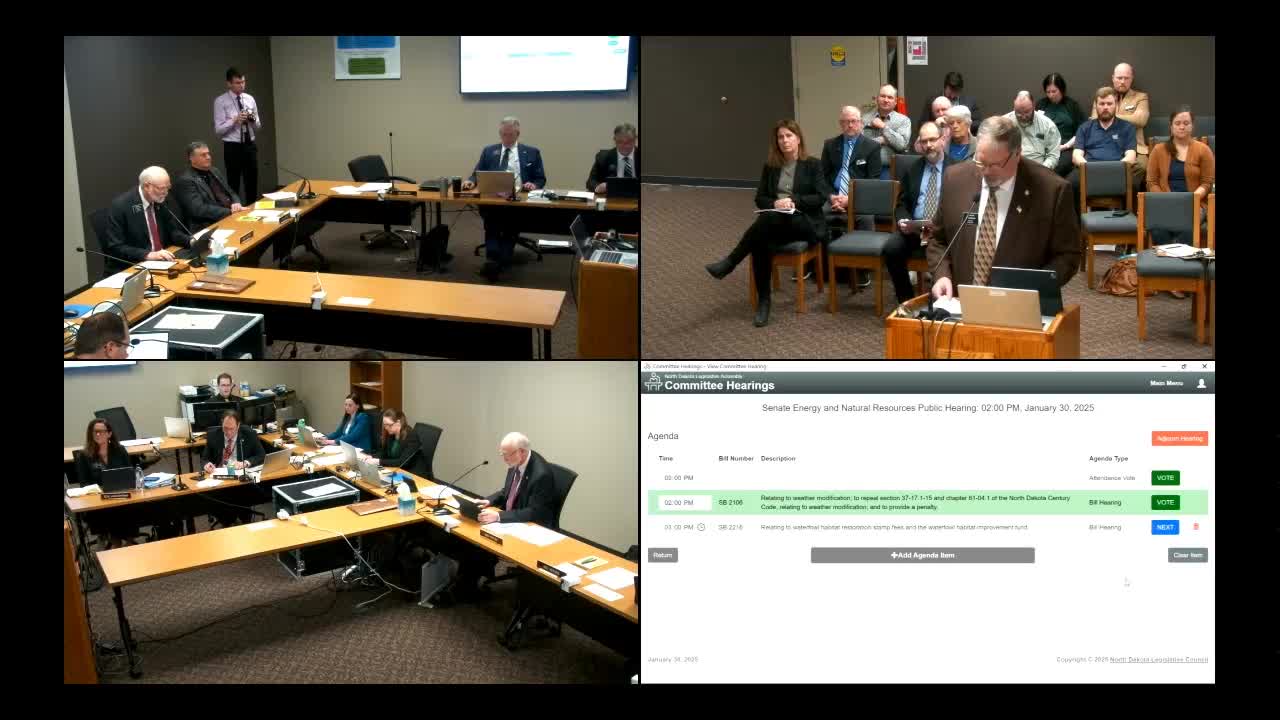North Dakota Senate hears calls to end controversial weather modification program
January 30, 2025 | Energy and Natural Resources, Senate, Legislative, North Dakota
This article was created by AI summarizing key points discussed. AI makes mistakes, so for full details and context, please refer to the video of the full meeting. Please report any errors so we can fix them. Report an error »

During a recent Senate Energy and Natural Resources meeting in North Dakota, significant discussions centered around Senate Bill 2106, which seeks to end the state's weather modification program. This program, which has faced increasing scrutiny, currently operates in only two and a half counties, down from 38 in the past. Testimonies from local farmers and community members highlighted concerns over the program's effectiveness and transparency.
Roger Nasham, a farmer from Ward County, expressed strong opposition to the weather modification efforts, arguing that they primarily benefit those involved in the program rather than the broader community. He recounted his experiences on the weather modification authority board, where he felt that public concerns were consistently ignored. Nasham emphasized that the program's claims of success are unfounded, citing a lack of measurable benefits and widespread public disapproval. He noted that if the program were put to a statewide vote, it would likely face overwhelming opposition.
John Wert, another farmer, supported Nasham's claims, stating that studies promoting weather modification often rely on flawed data. He pointed out that many counties have withdrawn from the program due to its perceived negative impacts, questioning the justification for continuing it in the remaining areas. Wert drew parallels between weather modification and environmental concerns, suggesting that the program's operations could harm neighboring counties without their consent.
The testimonies reflect a growing sentiment among local residents that the weather modification program does not serve their interests and may even pose risks to their agricultural livelihoods. As the Senate considers the bill, the community's call for transparency and accountability in weather modification practices is becoming increasingly clear. The outcome of this legislation could reshape how North Dakota approaches weather management and agricultural support in the future.
Roger Nasham, a farmer from Ward County, expressed strong opposition to the weather modification efforts, arguing that they primarily benefit those involved in the program rather than the broader community. He recounted his experiences on the weather modification authority board, where he felt that public concerns were consistently ignored. Nasham emphasized that the program's claims of success are unfounded, citing a lack of measurable benefits and widespread public disapproval. He noted that if the program were put to a statewide vote, it would likely face overwhelming opposition.
John Wert, another farmer, supported Nasham's claims, stating that studies promoting weather modification often rely on flawed data. He pointed out that many counties have withdrawn from the program due to its perceived negative impacts, questioning the justification for continuing it in the remaining areas. Wert drew parallels between weather modification and environmental concerns, suggesting that the program's operations could harm neighboring counties without their consent.
The testimonies reflect a growing sentiment among local residents that the weather modification program does not serve their interests and may even pose risks to their agricultural livelihoods. As the Senate considers the bill, the community's call for transparency and accountability in weather modification practices is becoming increasingly clear. The outcome of this legislation could reshape how North Dakota approaches weather management and agricultural support in the future.
View full meeting
This article is based on a recent meeting—watch the full video and explore the complete transcript for deeper insights into the discussion.
View full meeting
